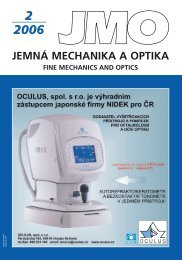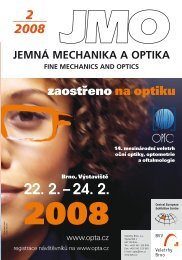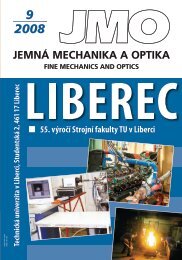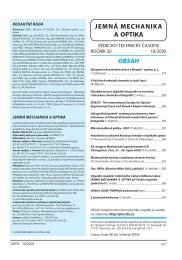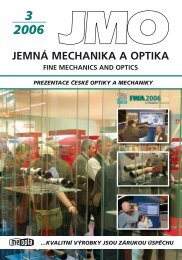technická univerzita v liberci fakulta strojní - Jemná mechanika a ...
technická univerzita v liberci fakulta strojní - Jemná mechanika a ...
technická univerzita v liberci fakulta strojní - Jemná mechanika a ...
You also want an ePaper? Increase the reach of your titles
YUMPU automatically turns print PDFs into web optimized ePapers that Google loves.
Hamid SARRAF a,b , Petr LOUDA b<br />
a Danish Polymer Centre, Risø National Laboratory, Roskilde, Denmark<br />
b Faculty of Mechanical Engineering, Technical University of Liberec, Liberec, Czech Republic<br />
Effect of plasma treatment on fine mechanical properties<br />
of PAN-based carbon fibers<br />
3/2007<br />
In the present work the surfaces of the polyacrylonitrile (PAN)-based carbon fibers were physically<br />
treated using cold plasma in argon and oxygen atmospheres, in order to modify and improve the fine<br />
mechanical properties of the carbon fibers used in the fiber reinforced polymer composites. The physical<br />
and morphological changes of the surfaces were investigated by tensile strength tests and scanning<br />
electron microscopy (SEM). It was found that the oxygen plasma treatments caused ablation of the carbon<br />
fiber surface, removing carbon atoms such as CO and CO 2 molecules. In addition, the argon plasma<br />
treatment eliminated defects on the fiber surface, reducing the size of critical flaws and thus increasing<br />
the fiber’s tensile strength. A comparison of the methods applied provides a largely consistent image<br />
of the effect of plasma treatment on the fine mechanical properties.<br />
Keywords: PAN-based carbon fiber; Plasma treatment; Argon & oxygen gas flows; Tensile strength<br />
1. INTRODUCTION<br />
Polyacrylonitrile (PAN)-based carbon fibers are currently being<br />
applied as the reinforcement in both thermoset and thermoplastic<br />
matrix composites [1,2]. However, when applied without previous<br />
surface treatment, these fibers produce composites with low<br />
interlaminar shear strength (ILSS). Numerous methods have been<br />
developed to improve the fiber surface wettability or to increase<br />
the quantity of surface functional groups [3,4]. The interfacial bond<br />
between the carbon filaments and the resin matrix can be enhanced<br />
by enlarging the surface area, which provides more points of contact/anchorage<br />
between the fiber and the matrix, or by enhancing<br />
the physicochemical interaction between the components [4].<br />
Oxidation methods consist of oxidizing the carbon fiber in a liquid<br />
or gas environment to form oxygen-containing functional groups<br />
such as carboxyl, carbonyl, lactone and/or hydroxyl groups on the<br />
surface of the fiber, while simultaneously increasing the surface area<br />
of the carbon fiber [5]. Several studies have attempted to generate<br />
strong adhesion between the fiber surface and matrix [3,6-8] to<br />
improve the stress transfer from the relatively weak and compliant<br />
matrix to the strong and stiff reinforcing fibers [6,10]. In this<br />
study, the surfaces of the carbon fibers were physically modified<br />
using cold plasma in argon and oxygen atmospheres. The treated<br />
and untreated (as-received) surfaces of the carbon fibers were<br />
subjected to detailed characterization. The physical aspects of the<br />
surfaces were examined by scan ning electron microscopy (SEM)<br />
and tensile strength tests.<br />
2. MATERIALS AND METHODS<br />
2.1. Carbon fiber<br />
The carbon fiber studied in this experiment was a PAN (polyacrylonitrile)-based<br />
type, with 12 000 filaments per tow, manufactured<br />
by Tenax Fibers GmbH Co. The volumetric density for 12k<br />
carbon fibers was (1.77 ± 0.02) gcm -3 and their linear density (0.764<br />
± 0.002) gm -1 , respectively.<br />
2.2. Plasma treatment<br />
The plasma processing was carried out in a home-built inductively<br />
coupled cylindrical pulsed RF plasma reactor (Fig. 1).<br />
A continuous flow of oxygen and argon carrier gas was employed in<br />
the two distinct treatments. The carbon fiber samples were treated<br />
in the chamber under a pressure of 4.0×10 -1 mbar, and a current of<br />
30 mA and 480V. The treatments in the argon atmosphere lasted<br />
10 and 20 minutes, while those in the oxygen atmosphere lasted 2,<br />
5 and 10 minutes. The literature reports typical plasma treatments<br />
of fibers of 1 to 30 min utes under a low pressure of 10 -2 -10 1 mbar<br />
[7]. Upon conclusion of the treatments, the samples were kept in<br />
a dryer in an argon atmosphere prior to their analysis.<br />
Fig. 1 Schematic of the pulsed RF plasma system<br />
2.3. Mechanical properties via tensile strength tests<br />
The mechanical properties of the untreated and treated carbon<br />
fiber samples (single filaments) were measured using an Instron<br />
Uni versal testing machine with a gauge length of 25 mm (Figure<br />
2) and a crosshead speed of 2.5 mm/min, according to the ASTM<br />
D 3379-75 (Standard test method for tensile strength and Young’s<br />
modulus for high-modulus single-filament materials) [8].<br />
71



